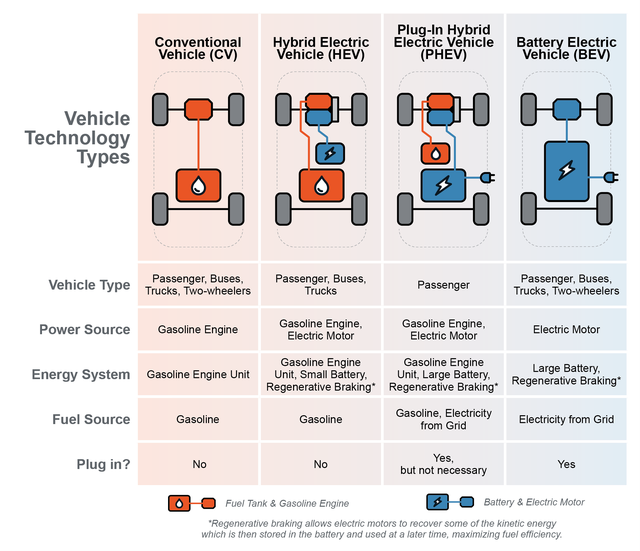Technology Basics
Skip to:
Introduction
Electric vehicles (EVs) take many forms (e.g. passenger vehicles, trucks, buses, and two-wheelers) and use different powertrain technologies (e.g. hybrid electric, plug-in hybrid electric, battery electric). They offer many benefits compared to conventional vehicles that use internal combustion engines, but also face numerous barriers to deployment (see figure below).

Figure 1: EV Technology Types
Table 1: Benefits and Barriers of EVs
|
Benefits of EVs |
Barriers to EV Deployment |
|
|
Globally, while deployment of EVs is accelerating, they still only represent a small fraction of vehicle sales in most countries. China is currently leading the deployment of several types of EVs, including passenger vehicles, buses, and two-wheelers.
Reading List and Case Studies
TUMI Transport Outlook 1.5°C - A global scenario to decarbonise transport
Transformative Urban Mobility Initiative (TUMI), 2021
The transportation sector accounts for almost a quarter of global energy-related carbon emissions. A significant reduction in emissions from transportation is crucial to achieve the targets of the Paris Agreement--to limit global temperature rise to under 1.5°C and avoid the worst impacts of climate change. The Transformative Urban Mobility Initiative (TUMI) Transport Outlook 1.5°C--produced as a collaboration between TUMI and the University of Technology Sydney--details how we can achieve this goal with a scenario study. The scenarios in this study include a reference baseline study, which is the business-as-usual scenario with no changes to the transportation sector, and two temperature rise target scenarios, which include the necessary transformations to limit global temperature rise to 1.5 ̊C and 2.0 ̊C.
Electrifying Transit: A Guidebook for Implementing Battery Electric Buses
National Renewable Energy Laboratory, 2021
The use of battery electric bus (BEBs) fleets is becoming more attractive to cities seeking to reduce emissions and traffic congestion. This guidebook is designed for decision-makers who may be considering implementing battery electric busses (BEBs), and includes potential solutions to address challenges such as upfront cost premiums, planning burdens, and BEB range that may slow development. BEB facts, data, and considerations for policymakers are identified, along with potential impacts of BEB on the electric grid and specific operation and maintenance considerations for BEBs. The report also discusses BEB costs and financing options, safety of BEBs and the associated codes and standards, hazards, and emergencies. Finally, the report examines project execution and long-term planning considerations.
Bloomberg New Energy Finance (BloombergNEF), 2020
Electric Vehicle Outlook is BloombergNEF's annual long-term forecast of how electrification, shared mobility, and autonomous driving will impact road transport from now through 2040. The executive summary, available to the public, summarizes the full report’s results. The report covers light duty passenger vehicles, commercial vehicles, buses, and two or three-wheeled vehicles. The report draws on BloombergNEF's team of specialists around the world and looks at how these trends will impact the automotive, energy, infrastructure, and battery materials markets over the next 20 years.
International Energy Agency, 2020
Global EV Outlook is an annual publication that identifies and discusses recent developments in electric mobility across the globe. The report examines key areas such as EV and charging infrastructure deployment, ownership cost, energy use, carbon dioxide emissions and battery material demand. This edition features case studies on transit bus electrification in Kolkata (India), Shenzhen (China), Santiago (Chile) and Helsinki (Finland). The report includes policy recommendations that incorporate learning from frontrunner markets to inform policy makers and stakeholders who are considering policy frameworks and market systems for EV adoption.
Foundations of an Electric Mobility Strategy for the City of Mexicali
National Renewable Energy Laboratory, 2020
While the municipality of Mexicali, Mexico has goals energy, environmental, and mobility goals, it still faces challenges related to greenhouse gas emissions, air pollution, and traffic congestion. This report seeks to support Mexicali in achieving these goals and overcoming challenges by describing technical pathways to transportation electrification and providing targeted analysis to inform Mexicali’s electromobility strategy. This report presents a custom-designed, practical, and data-driven framework to enable Mexicali to transition their transport sector to cleaner electric mobility. It includes a brief overview of the benefits of electric vehicles, considerations for electricity grid preparation and management, and ways to prioritize and incentivize fleets for electrification. Also discussed are the expansion of the individual PEV market through deployment of EVSE and other incentives, and capacity building and training of PEV repair technicians, EVSE installation electricians, and first responders, so that PEVs and related infrastructure remain safe, effective, and reliable.
Electrifying Transport in USAID Partner Countries: Key Issues and Case Studies
National Renewable Energy Laboratory, 2020
In this webinar, leading experts from the National Renewable Energy Laboratory share insights about key topics related to EV deployment. Real-world examples and case studies of EV analysis from Jamaica, Mexico, and the United States are also featured.
The Value of Motorcycle Electrification in Mexico City
National Renewable Energy Laboratory, 2020
Mexico City faces a multitude of transportation challenges including poor air quality, traffic congestion, and inequitable access to transit. This brief discusses the potential benefits of motorcycle electrification in Mexico City. Through a series of stakeholder working group engagements, researchers discovered that city officials wanted to improve air quality and mobility access in Mexico City and saw motorcycle electrification as a potential pathway to do so. Researchers conducted a technical evaluation of the potential benefits of motorcycle electrification, demonstrating that partial electrification of motorcycles could result in a meaningful reduction in air pollutants.

